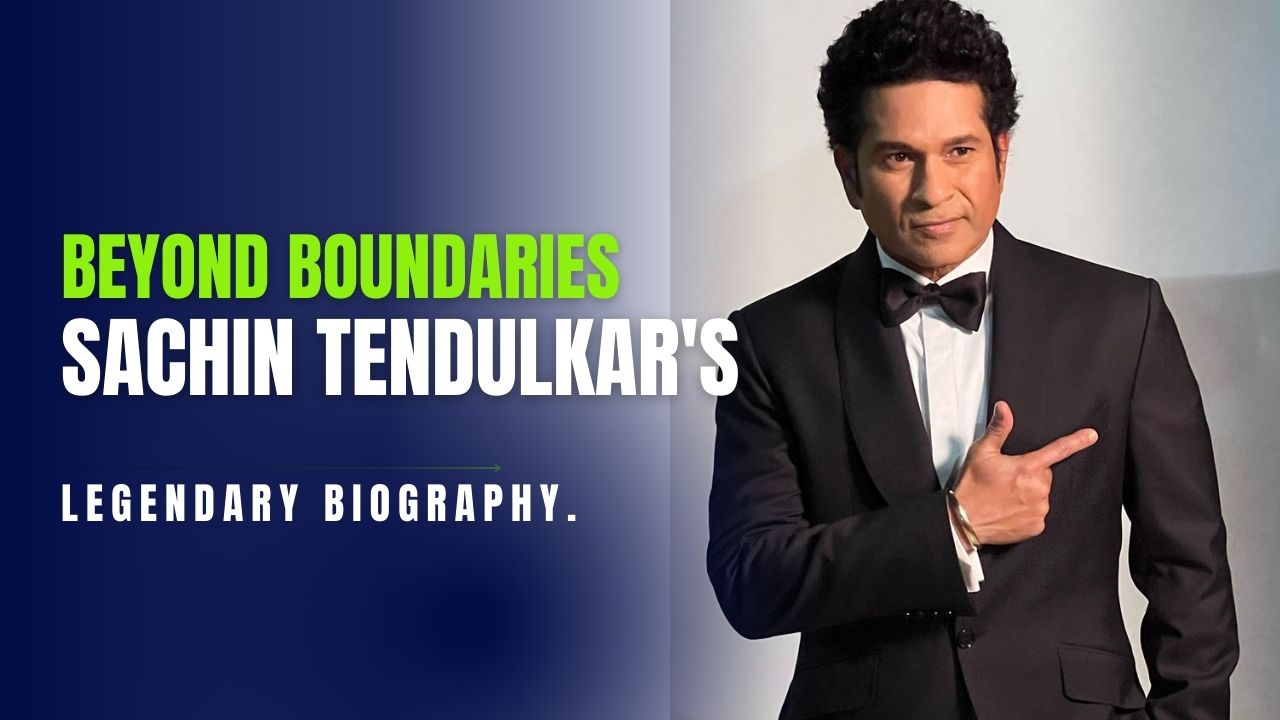Sachin Tendulkar BIOGRAPHY
Introduction
Sachin Tendulkar, the name that resonates with cricket lovers worldwide, is more than just a sportsman. He’s an icon, a legend, and for many, the very embodiment of the sport. Often referred to as the “God of Cricket,” his achievements and records have set a benchmark that aspiring cricketers dream of reaching. But beyond the numbers and the accolades lies the story of a boy who fell in love with cricket on the streets of Mumbai and went on to become a global phenomenon.
Early Life
Born on April 24, 1973, in Mumbai, Sachin was the youngest of four siblings. His father, Ramesh Tendulkar, was a well-known Marathi novelist, while his mother, Rajni Tendulkar, worked in an insurance company. From a very young age, Sachin showed a deep fascination for cricket. He was always full of energy, often playing in the gallis (lanes) of his neighborhood. His elder brother, Ajit Tendulkar, noticed his talent and decided to take him to coach Ramakant Achrekar, one of Mumbai’s most respected cricket coaches
At Sharadashram Vidyamandir, under Achrekar’s mentorship, Sachin’s potential flourished. He would often practice for hours, playing match after match, and this intense dedication made him stand out. His childhood wasn’t just about talent; it was about sheer hard work, passion, and discipline. While his friends would play for fun, Sachin was always focused, driven by his dreams.
Education life
Sachin Tendulkar’s formal education was quite basic, as his focus shifted early towards cricket. Here’s a summary of his education:
School: Sachin attended Shardashram Vidyamandir High School in Dadar, Mumbai. This school became significant in his life as it had a strong cricketing culture, and it was here that his talent was nurtured by his coach, Ramakant Achrekar.
Academic Focus: While Sachin was enrolled in school, his academic performance was not notable. His passion for cricket meant that he spent most of his time on the field, training and playing matches, rather than focusing on academics.
Early Career: By the time Sachin was 16, he had already made his debut for the Indian cricket team in 1989, which limited his time for formal education further.
Entry into Cricket
Sachin’s rise in the cricketing world was swift. At just 14 years old, he grabbed headlines with a remarkable 664-run partnership with his friend Vinod Kambli in an inter-school match. This match brought him into the spotlight, making him a talking point among cricket enthusiasts in Mumbai.
By the age of 15, Sachin made his debut in first-class cricket, playing for Mumbai in the Ranji Trophy. He didn’t just participate—he scored a century in his debut match, becoming the youngest Indian to do so. Soon after, at just 16, he was selected for the Indian national team, making his international debut against Pakistan in November 1989. Facing bowlers like Waqar Younis and Wasim Akram at such a young age was no easy task, but Sachin held his ground, showing the world glimpses of what was to come.
International Cricket Career
Sachin’s journey in international cricket wasn’t always smooth in the beginning, but his raw talent was undeniable. His first Test century came in 1990, against England at Old Trafford, a knock that marked the beginning of a legendary career. From that moment on, he kept setting new records and breaking old ones. Whether it was Tests, One Day Internationals (ODIs), or even T20s, Sachin became a force to be reckoned with.
Over the next two decades, Sachin gave cricket fans countless memories. His back-to-back centuries, his ability to take on the best bowlers, and his calm demeanor under pressure made him a fan favorite. The 1996 World Cup, where he emerged as the tournament’s highest run-scorer, solidified his reputation as one of the best batsmen in the world.
One of his career’s iconic moments came in 2003, when India reached the World Cup final under his guidance. Though India lost to Australia, Sachin’s performance throughout the tournament was nothing short of extraordinary. His consistency across all formats and his ability to deliver in high-pressure situations set him apart from others.
Achievements and Records
Sachin Tendulkar’s records are the stuff of legend. The first cricketer to score 100 international centuries, the first player to reach 200 runs in an ODI, and the highest run-scorer in both Test and ODI cricket—his achievements are unparalleled. But beyond the records, it’s the joy he brought to fans, the way he played the game, and his sportsmanship that made him the legend he is.
He received numerous awards throughout his career, including the Rajiv Gandhi Khel Ratna, India’s highest sporting honor, the Padma Shri, and the Padma Vibhushan. In 2014, he became the youngest recipient of the Bharat Ratna, India’s highest civilian award, a testament to his contribution not just to cricket, but to Indian society as a whole.
Injuries and Comebacks
Despite his success, Sachin’s journey wasn’t without its challenges. Over the years, he faced multiple injuries—most notably his troublesome tennis elbow that kept him out of the game for extended periods. Each time he faced an injury, there were whispers that maybe this was the end of the Master Blaster.
But Sachin’s resilience and mental strength saw him come back stronger each time. He adjusted his game to accommodate the physical limitations that injuries imposed, proving time and again that champions are defined not by how they avoid failure, but by how they overcome it.
World Cup Journey
The World Cup was always special for Sachin. Having played in six editions from 1992 to 2011, Sachin’s dream was to lift the World Cup trophy. His near-miss in 2003 was a heartbreak for the nation, but he never gave up.
In 2011, after years of waiting, Sachin’s dream finally came true. India won the World Cup, and it was a fitting farewell to the tournament for Sachin. The victory was a gift from his teammates to their “elder brother.” The image of Virat Kohli and others carrying Sachin on their shoulders, celebrating India’s win, remains etched in the minds of every Indian cricket fan.
Retirement
In December 2012, Sachin retired from ODIs, and in November 2013, he played his final Test match. His 200th Test match, held at his home ground in Mumbai, was an emotional affair, as the entire nation came together to bid farewell to their beloved cricketer. His farewell speech, where he thanked his fans, family, and teammates, left not a single dry eye in the stadium or for those watching at home.
With his retirement, an era in Indian cricket came to an end. But Sachin’s impact on the sport is everlasting.
Life After Retirement
Post-retirement, Sachin didn’t fade away from the public eye. He has remained actively involved in promoting sports in India, encouraging young athletes to pursue their dreams. His autobiography, Playing It My Way, became a bestseller, offering fans a deeper insight into his life and career.
Sachin is also involved in several charitable causes, supporting education and healthcare initiatives across India. He continues to serve as a mentor and role model for countless young cricketers, showing them that success comes with discipline and perseverance.
Personal Life
Despite his worldwide fame, Sachin has always been a family man. He married Anjali Mehta in 1995, and the couple has two children, Arjun and Sara. Arjun, like his father, is pursuing a career in cricket, while Sara has kept a low profile. Sachin’s humility, despite his incredible success, has been one of his most admired qualities.
Legacy
Sachin Tendulkar’s legacy is not just about the countless records he set or the matches he won for India. His influence transcends cricket. He brought a sense of unity to a cricket-crazy nation, where people from different backgrounds, regions, and beliefs came together to support him. His dedication, humility, and passion for the game inspired millions, not only in India but around the world.
Even after his retirement, Sachin continues to inspire young cricketers like Virat Kohli and Rohit Sharma, who have often spoken about his influence on their careers. Sachin’s work ethic, discipline, and attitude toward the game have set the gold standard for future generations.
Through his cricketing genius, he proved that with talent, hard work, and the right attitude, one can achieve greatness. Beyond his achievements, it’s his ability to stay grounded, maintain humility, and serve as a role model that truly defines Sachin’s legacy.
Conclusion
Sachin Tendulkar’s journey from the streets of Mumbai to becoming the most celebrated cricketer in history is a story of hard work, perseverance, and passion. His contribution to Indian cricket is immense, and his influence on the sport will continue to shape future generations of cricketers. Though he has retired from professional cricket, Sachin Tendulkar will forever remain a symbol of excellence, dedication, and humility.








